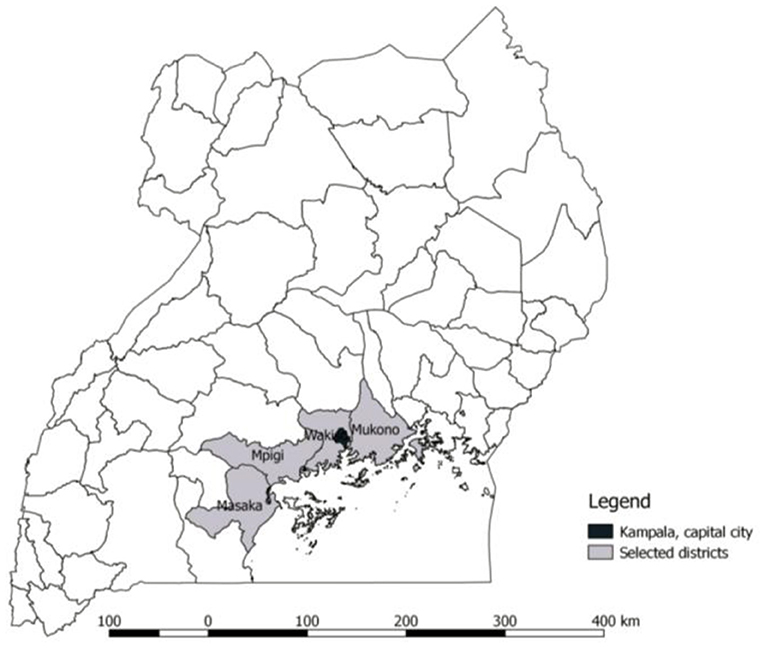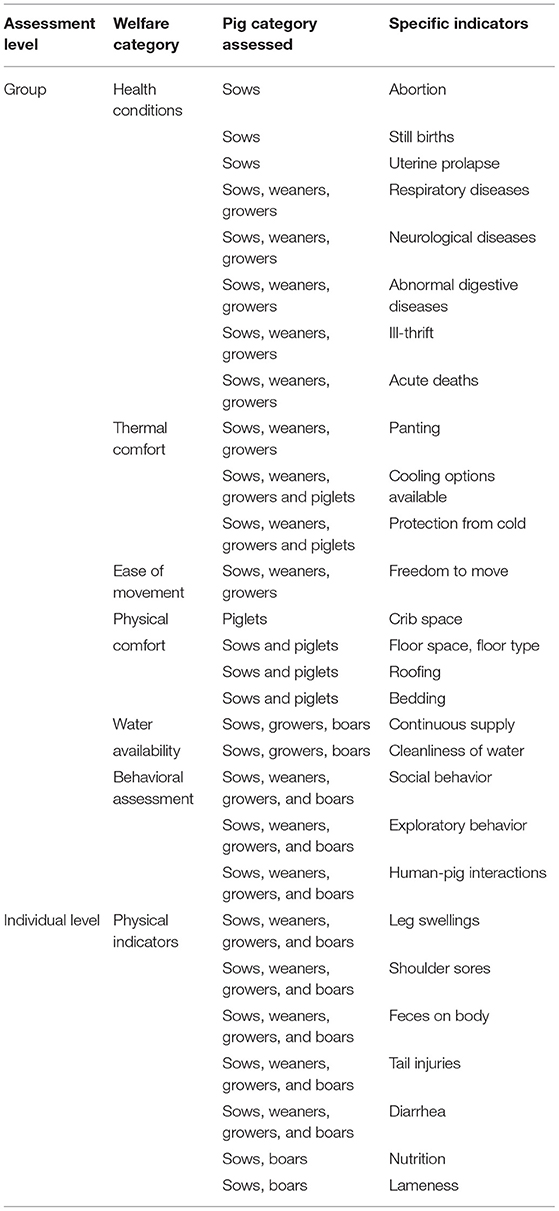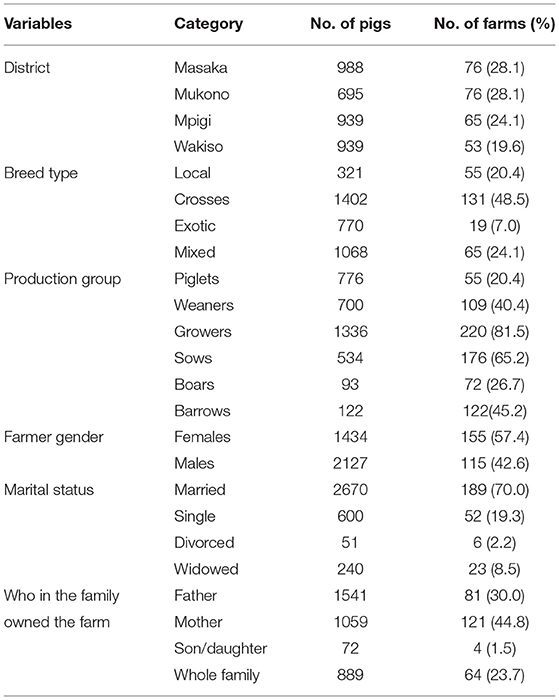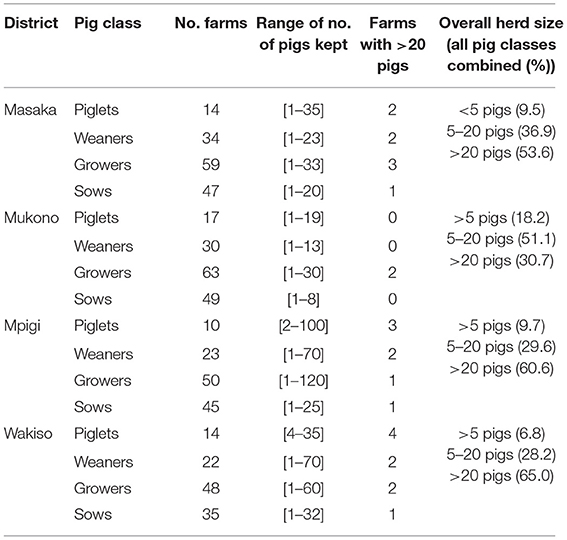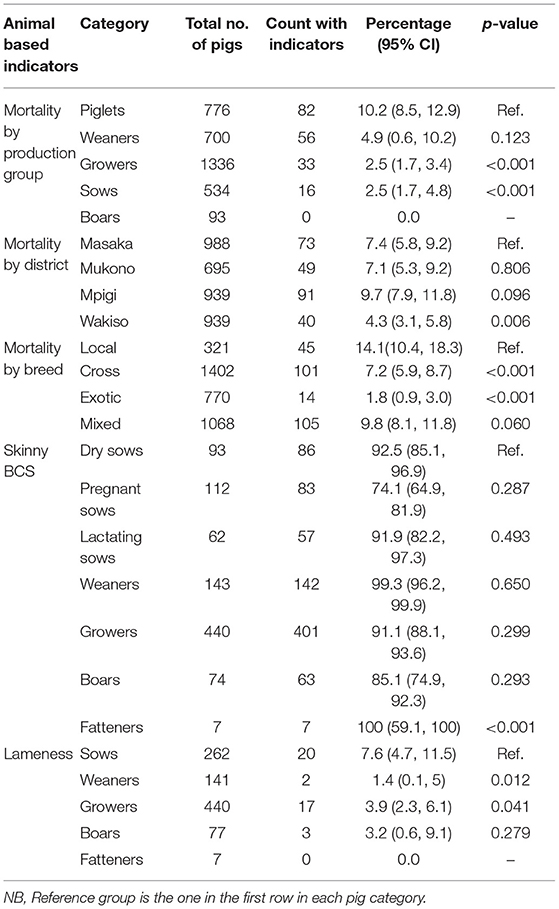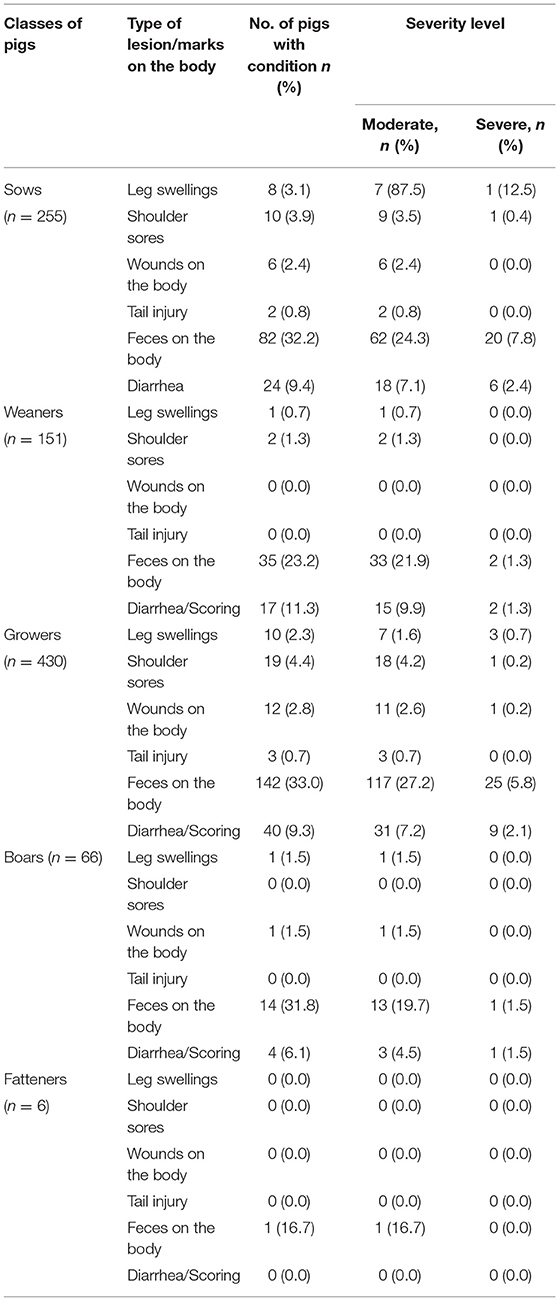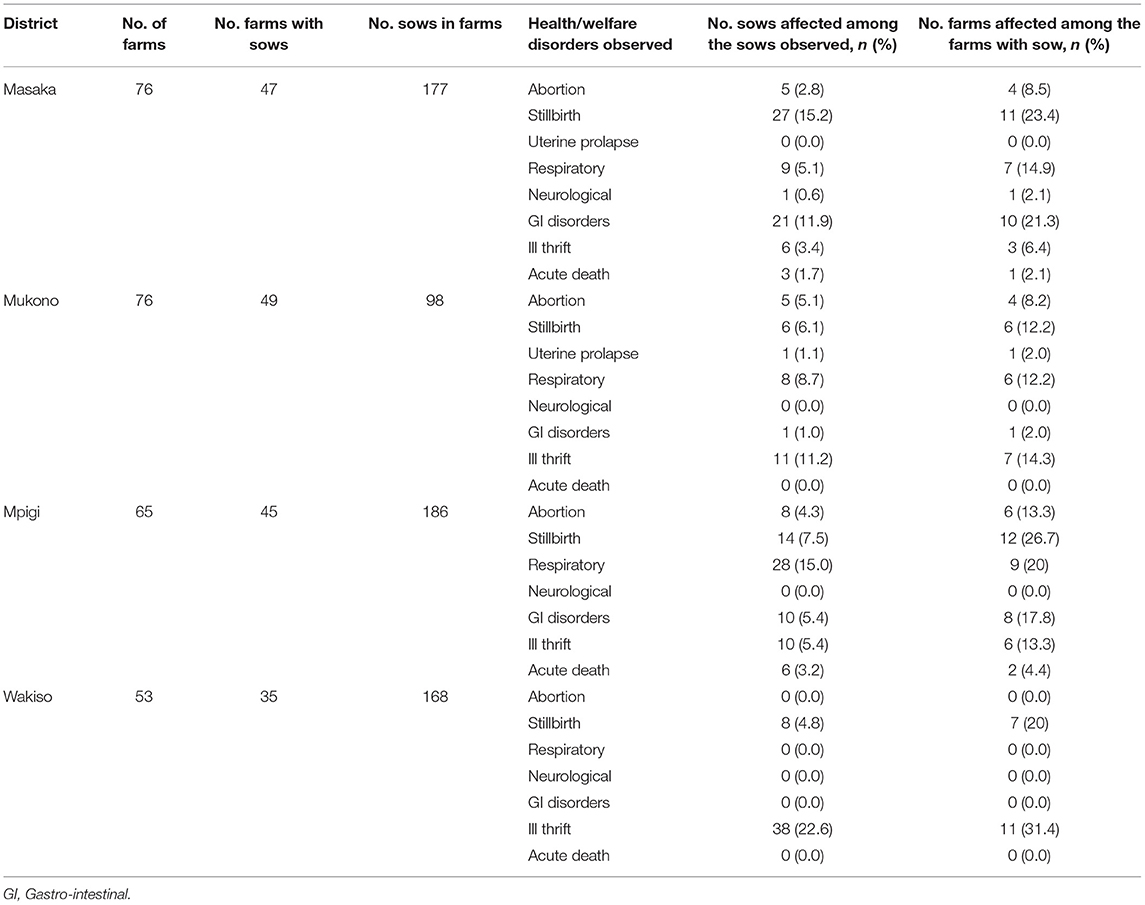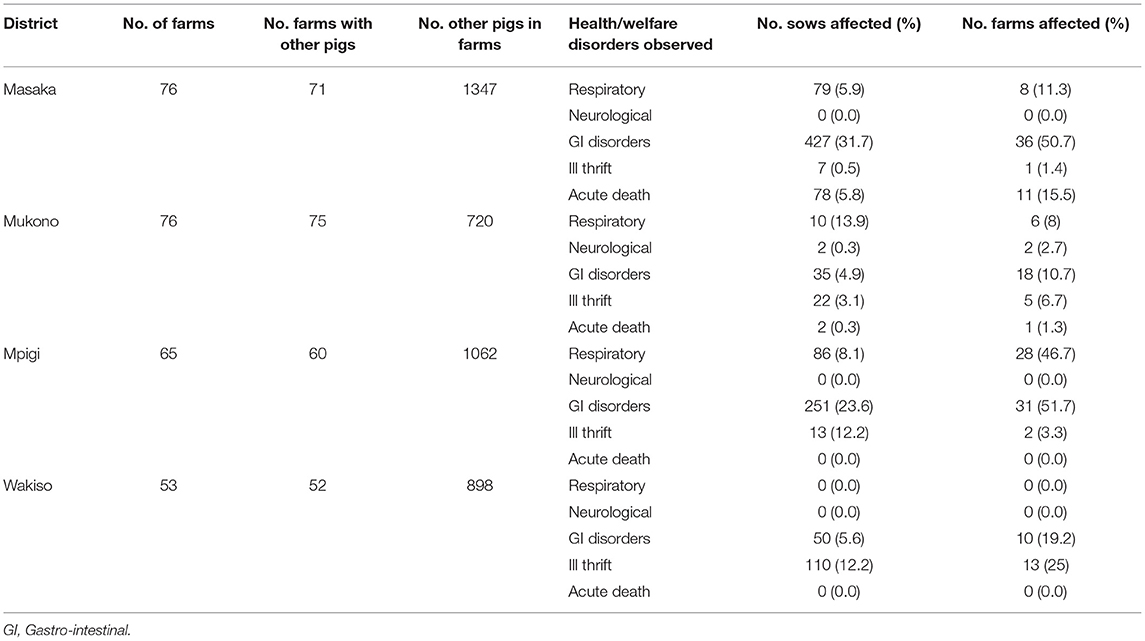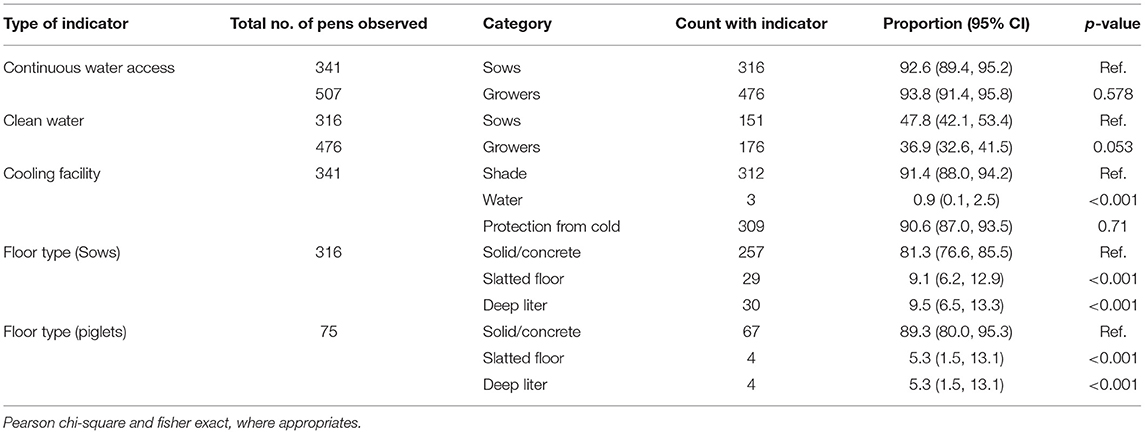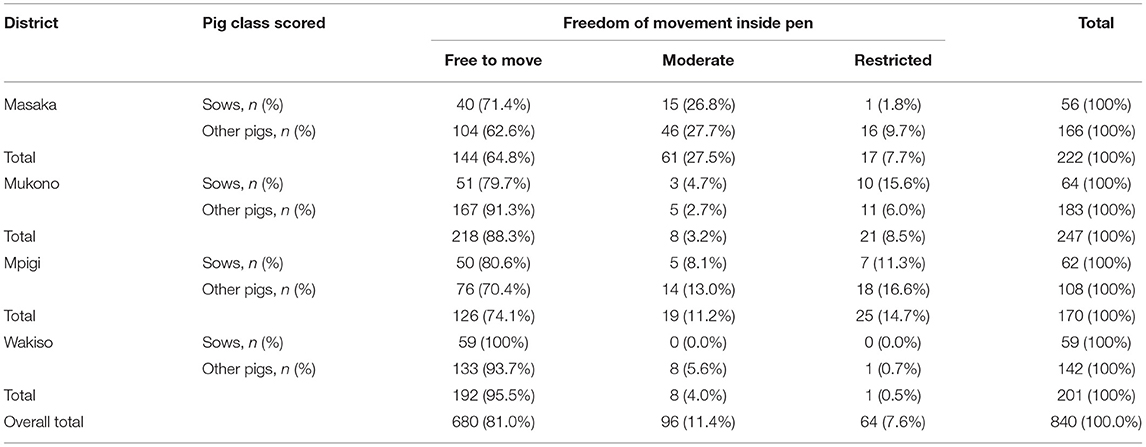- 1Animal and Human Health Program, International Livestock Research Institute, Dakar, Senegal
- 2Animal and Human Health Program, International Livestock Research Institute, Kampala, Uganda
- 3College of Veterinary Medicine, Animal Resources and Biosecurity, Makerere University, Kampala, Uganda
- 4Faculty of Veterinary Medicine, Hawassa University, Hawassa, Ethiopia
- 5Animal and Human Health Program, International Livestock Research Institute, Addis Ababa, Ethiopia
- 6The Royal (Dick) School of Veterinary Studies, University of Edinburgh, Edinburgh, United Kingdom
We conducted a pig welfare survey in four high pig producing districts in central Uganda, namely Masaka, Mukono, Mpigi, and Wakiso in 2021. Data were collected from 270 pig farms, and a total of 3,561 pigs, and consisted of resource-based (housing and water supply), animal-based (pig body condition and physical injuries), and management-based (records of morbidity and mortality) indicators of pig health and welfare. Data on animal and resource-based indicators were obtained from physical assessments of pigs and farm facilities, while management indicators and demographic details were collected by farmer interview. Across all farms, sow mortality in the last 12 months was reported to be 2.5% (95% Confidence Interval: 1.7, 4.8%). Animal-based indicators identified 9% (6.1, 13.7%) of sows with scouring/diarrhea, 7.6% (4.7, 11.5%) with lameness and 92% (85.1, 96.7%) of dry or lactating sows were found to be “skinny” with a body condition score of 1 or 2. In addition, piglet mortality was as high as 10.2% (8.5, 12.9%). A total of 19% of sows were partially or completely restricted from free movement inside pens. Ninety-three per cent of sows had continuous access to water, but only 48.8% of the water supplies were clean. Twenty per cent of farms reported sows experiencing stillbirths , 15% reported ill thrift, 12.5% reported respiratory disease and 10.8% reported gastrointestinal disease. Wakiso district registered the lowest pig mortality which was significantly lower compared to the other three districts. This study reveals that Ugandan pigs are exposed to severe undernutrition, dirty water, high mortality, physical injuries, poor housing, and health challenges (stillbirth, ill thrift, and Gastrointestinal disorders). Meaningful change to farmer livelihoods and pig welfare can be made by designing simple interventions that target improve housing structures, provision of cooling facilities especially during hot periods (heat stress) and bedding materials. The findings also represent a benchmark for the assessment of the effect of such interventions designed to improve farm health and productivity.
Introduction
Compromised animal welfare affects the economic sustainability of livestock agriculture in more than one way, with reduced productivity being importantly regarded as its consequence. Without objective quantification, welfare standards cannot be properly defined and compared, nor can the efficacy of corrective measures be assessed (Deen, 2010). Animal welfare is globally recognized as a component of the United Nations Sustainable Development Goals (SDGs) for ensuring sustainable food production due to its linkage with livestock productivity, food safety, and environmental health (Doyle et al., 2021). It is an integral aspect of herd health management which directly affects livestock productivity. The positive relationship between animal welfare and productivity has long been recognized (Lyons et al., 1995; EFSA Panel on Animal Health Welfare, 2012b). This relationship underscores the importance of welfare for example in the pig production in addressing challenges to productivity, herd health and ultimately the livelihoods' of producers.
In Uganda, pig production has dramatically increased over the last three decades owing to the growing demand for pork (Ouma et al., 2017). Estimates show the national pig population in the country in 2018 was 4.47 million pigs produced by 1.34 million households (UBOS, 2021). Pig production is a large informal sector characterized my mainly backyard systems with small stock of animals that are kept free-roaming or tethered. Smallholder production systems predominate and are described as free-range, semi-intensive or intensive systems in which farmers keep a small number of pigs, usually between 2 and 20. As we moved to peri-urban and urban settings, total or partial confinement of pigs through housing increases with higher herd size observed (Muhanguzi et al., 2012; Ouma et al., 2014). Minimal health care is given to pigs in these systems, making other pathogens such as helminths (Roesel et al., 2017), respiratory complexes (Dione et al., 2018) being highly prevalent. Pigs reared in rural areas are mostly fed on crop residues or forages, while those in peri-urban or urban areas are mostly fed on leftover unprocessed food from restaurants and households. Farmers with high financial capacity may access commercial formulated feeds and concentrates or make their own feeds from maize grain, maize bran and other local ingredients. The feeding strategies change depending on availability of feed resources, which follow a seasonal pattern (Carter et al., 2018; Ouma, 2021). The pig industry in Uganda faces many constraints, notably diseases such as African swine fever (ASF), poor biosecurity and poor knowledge among value chain actors on good management and inefficient value chains. Poor hygiene on pig farms, low biosecurity practices, and inappropriate behaviors of value chain actors increase the risk of infectious disease outbreaks such as ASF (Nantima et al., 2015a,b; Dione et al., 2018). All these constraints are somehow linked to poor animal welfare. Animal welfare is neglected by various value chain actors, partly due to gap in knowledge and information of its impact on pig health and productivity. While animal welfare is overlooked by disease control policy makers, laws and regulations that govern animal disease control exist in Uganda, but their enforcement remains a major challenge (Dione et al., 2014a). To improve pig productivity, knowledge gaps on pig welfare and its socio-economic impact among farmers and other value chain actors needs to be addressed.
This study was carried out within the More Pork II Project: “Improving pig productivity and incomes through an environmentally sustainable and gender inclusive integrated intervention package” implemented by the International Livestock Research Institute (ILRI) in Uganda (Ouma, 2021). The main project goal is to deliver an integrated package of technologies to value chain actors to improve productivity and overall efficiency of the pig value chain. A basket of technologies including herd health, improved genetics and reproductive management, and nutrition are integrated within interventions. These technologies are linked to marketing arrangements and the ICT-based “PigSmart platform” to enhance adoption by actors. The key objective under the animal health component was to improve overall pig health through welfare.
Therefore, this study was designed to assess the status of pig welfare in smallholder pig farms in selected districts in Uganda. The results will serve as a baseline for assessing impacts of interventions on pig welfare, health, and productivity in the project areas.
Materials and Methods
Study Area
This survey was conducted in central Uganda in Masaka, Mukono, Wakiso, and Mpigi districts from April to May 2021. Figure 1 below shows a map of the study sites. These four districts represent 40.2% of the pig population in central Uganda and 16.5% in Uganda in 2019 (UBOS, 2021). Two districts (Mukono and Masaka) were randomly selected as the project intervention sites, while the other two (Mpigi and Wakiso) were selected as the control sites.
Data Collection
A structured questionnaire was developed to collect quantitative and qualitative welfare indicators. The questionnaire was pretested in Wakiso and Mukono districts by the investigators and revised before field use. The tool was configured in Open Data Kit (ODK) to ease data collection. The tool captured information on farm demographics, herd structure, and pig health conditions (diseases, mortalities etc.) through farmer interview; then farm resources, facilities and pig welfare indicators were directly observed by the investigators. The tool was designed in a way that enabled objective assessment of welfare indicators based on established scientific guidelines (EFSA Panel on Animal Health Welfare, 2012a). This overall framework was adapted to suit Uganda's smallholder pig production settings. The welfare assessment was done at both group and individual pig levels.
Sample Size Determination
Pig farmers of the More pork II project represented the sampling frame (~650 farmers) from which random sampling was done. Among productivity constraints identified during the smallholder pig value chain assessment was poor housing (Ouma, 2021). Based on field experience, we estimate the current proportion of farms with good housing structures stands at 25%. Following the intervention training, we expect this proportion to rise to at least 30%.
Since we will sample the same farms in a before-and-after intervention design, the following binomial comparison equation was used to compute the required sample size (Dohoo et al., 2012):
where n0 = is the required total sample size; Zα/2 is the standard Z-score from a normal distribution (1.96), Zβ is the value of Z required for 80% power (−0.84); p0 = 0.25; p1 = 0.30, and d is the minimum detectable difference (0.05). Using this equation, the required total sample size of 274 farms was calculated. In this study, we sampled a total of 270 farms.
Sampling Methods for Farms, Pens, and Pigs
In each farm, selection of individual pens and pigs to sample for welfare assessment was done randomly. Different pig categories (sows, weaners, growers, and boars) were identified when scoring individual pigs for welfare indicators. In each farm, the enumerator obtained the total number of pens from which he/she randomly sampled a given number of pens. Where a pen had more than one pig, individual pigs were randomly sampled and scored for specific welfare indicators. When sampling individual pens and pigs, each pen and pig were allocated a (serial) number from which the enumerator selected a random sample. In each farm, one sow (max. of 5 sows and one weaner/grower (max. 7) were sampled for individual pig scores. In our survey, the herd size ranged from a minimum of one pig to a maximum of 317 pigs. Table 1 presents the welfare measures assessed in the study.
Operational Definitions
Exploratory Behavior
This was assessed by placing an object in the pen (a water bottle/bucket/shoe) and the enumerator observed how many curious pigs approached the object within 1 min (Welfare Quality, 2009).
Social Behavior
Negative social behavior was characterized by aggressive behavior, including biting, or aggressive nature in response to disturbance. Positive social behavior was defined as sniffing, nosing, licking, and moving gently away from other pigs without aggressive or flight reaction. Brief scans (~3 min) of social behavior of pigs were made at two min intervals as described (Welfare Quality, 2009).
Human-Animal Interaction
Sows, weaners, and growers were assessed for behavioral responses. Human-animal interaction was documented based on the reaction pigs manifested within <1 min after a familiar person (farmer/family member or an attendant in charge of the pigs) entered the pen.
Body Condition Score
Pigs with Body Condition Score (BCS) of ≤2 were classified as “skinny.”
Farm Owner age
“Young”: farmers aged between 17 and 35 years
“Mid age”: farmers aged between 36 and 50 years
“Old”: farmers were those above 50 years.
Data Management and Analysis
Data were collected both at group and individual animal levels. For group level, welfare assessment data were generally obtained at farm level. However, since one or more farm sub-units or pens were observed as distinct entities, pen was the smallest unit of analysis for herd level data. Once the data were captured it was cleaned, coded and validated. The validated data were transferred to STATA version 14 (Stata Corp., College Station, TX, USA) for descriptive and analytical statistics. Descriptive summaries for frequencies, proportions, and means with 95% Confidence Intervals were computed. Pearson/Fisher chi-square statistics were used to examine differences between categories depending on their frequency distribution. That is to say, in a situation where the frequency of observations was low (<10) fisher exact test was used, otherwise it was Pearson chi-square.
Results
Demographic Profile, Breeds Kept, and Production Type
Altogether data were generated from 270 farms in the four districts. Masaka (n = 76) and Mukono (n = 76) had the most farmers included in the survey, followed by Mpigi (65) and lastly Wakiso (53) district. All respondents were aged between 19 and 88 years and were classified into three categories: young, mid, and older age groups. The pig breeds in the farm were classified as local, exotic or crossed. A summary of demographic characteristics is given in Table 2.
Pig Herd Size and Herd Composition
Most pig farms kept a small number of pigs comprising of more than one age class (Table 3). Overall, 122 (45.2.9%) farms kept less than five pigs of different classes. More than 42% of the farms kept between 5 and 20 pigs. The remaining 12.6% of the farms comprise over 20 pigs of different production status. Among these, only two farms, one in Mpigi (n = 317) and the other in Wakiso (n = 186), had more than 100 pigs at the time of the survey. Across all farms, the mean number of sows kept was 2.3; of the 176 farms currently keeping sows, the mean herd size was 2.9 pigs. Three farms had >20 sows, ~10x the average number of sows per farm, and so arbitrarily indicative of large-scale production.
Animal and Record-Based Welfare Indicators
Mortality, Body Condition Scores, and Lameness
Mortality was highest in piglets (10.2%), which was statistically different from mortality in sows (p < 0.001) and growers (p < 0.001), but not statistically different from that of weaners (p = 0.123). Mpigi district had the highest (9.7%) mortality across all classes of pigs. Wakiso district had the lowest mortality across all pig classes (4.3%) and was statistically different from the reference district (Masaka) (p = 0.006). Farms with local breeds reported a higher mortality compared to those that kept crossed, exotic, and mixed breeds. The difference noted was statistically significant for all except farms with mixed breeds where it was marginal (p < 0.06). In terms of BCSs, most pigs were observed to be skinny. For locomotion, the highest proportion (7.4%) of lameness was seen among sows followed by growers (3.9%). The percent difference observed in mortality between weaners (4.9%) and growers (2.5%) was statistically significant (p < 0.01; Table 4). Of the lameness observed in sows, only three cases were assessed to be severe (15%) and 13 (65%) were moderately lame.
Physical Injuries or Discomfort
The most common indicator of poor welfare for all classes of pig, except piglets, was the presence of feces on the body of pigs, a sign of diarrhea. Shoulder sores, leg swellings and tail wounds were some of the lesions observed with varying degrees of severity in different classes of pigs as shown hereunder (Table 5).
Diseases and Syndromes Affecting Welfare of Sows
Stillbirths and respiratory diseases were the most reported health conditions in sows, but the frequency with which they were observed varied across the four districts (Table 6). Reproductive disorders such as uterine prolapse, stillbirth and abortions were reported in all four districts surveyed. Acute death appeared to be low and was reported only from two districts.
Health Challenges in Weaners, Growers, Fatteners, and Boars
Commonly observed syndromes in this class of pigs included diarrhea, coughing, anorexia, dullness, paralysis, and circling in pigs affected by Gastrointestinal (GI) disorders, respiratory distress, ill thrift, and neurological disorders, respectively (Table 7). At an individual animal and farm level, pigs in farms in Masaka and Mpigi had a high proportion of animals affected by GI disorders. Pigs in Mukono district had high animal level prevalence of respiratory syndromes; however, as far as distribution across farms is concerned, Mpigi district had by far the highest proportion of farms with pigs that showed signs of respiratory distress. While the number of pigs affected by ill thrift in Mukono and Wakiso districts were equal, Wakiso had the highest number of farms affected by this condition. Both at individual animal and farm levels, Masaka district had the most acute deaths reported. When they occurred, cases of acute death were mostly attributed to African swine fever (ASF).
Behavioral Assessment
Behavioral observations of the pigs considering social, exploratory, and human-animal interactions, summarized in Table 8. Overall, 95% of the pigs showed positive social behavior. Exploratory behavior and human-animal interactions were also generally positive as shown below.
Resource Based Indicators
Water Access and Quality
Housing facilities like spacing, floor type, presence or absence of crib space, water supply, and quality for different class of pigs were captured. As a part of immediate physiological necessity, consistent access and cleanness of the water supplied to pigs in the farms was the first issue considered; over 92% of the sows and close to 94% of growers had consistent water access. Nevertheless, only 48.8% of the water supply to sows and 36.9% to growers was considered clean enough for drinking. For thermoregulation purpose, water was rarely in use, rather, shade and cold protection was in place (Table 9).
Floor Type
In this survey, we noted the presence of three types of floors for all classes of pigs, namely, solid/concrete, slatted floor and deep litter. Of all floor types, 81.3% for sows and 89.3% for piglets were solid concrete, while the rest were either slatted floor or deep litter. In both production classes, there was a statistically significant difference in floor types when concrete type was used as reference (Table 9).
Ease of Movement
As to ease of movement, 81% (n = 680) of sampled pigs were free to move in their pens; 11.4% (n = 96) were moderately free to move while 7.6% (n = 64) were restricted from movement inside their pens (Table 10).
Discussion
Public concern for the welfare of farm animals has increased in recent years (Alonso et al., 2020). In some parts of the world this has led to a rise in demand, and willingness to pay, for higher welfare animal products (Kells, 2021). Intensive pig production systems are a source of stress and reduced animal welfare. In these systems, pigs are often housed in small or barren environments that prevent them from exhibiting their natural behaviors. This, in turn, increases the frequency of abnormal and stereotypic behaviors, indicating stress (Albernaz-Gonçalves et al., 2021). This stress can lower immunity of the pig making them more susceptible to infections (Filipe et al., 2020). Our study targeted intensive smallholder pig production systems in four districts of Uganda. These productions systems are characterized by low input, given that farmers often face many production challenges that negatively affect the quality of the pigs for the market.
Health Conditions of Sows and Other Classes of Pigs (Mortality and Disease Prevalence)
Mortality rates reported by farmers followed expected patterns with the highest mortality observed among piglets compared to weaners, growers, and sows. Mortality rates in piglets are commonly highest given their low innate immunity (Radostits and Done, 2007). In addition, pig farmers in Uganda often lack knowledge of best management practices (Dione et al., 2014b). This situation may have contributed to the high piglet mortality rates. Overall reported pig mortality was high in Mpigi district, followed by Mukono and Masaka districts. Wakiso district registered the lowest pig mortality which was significantly lower compared to the other three districts. This reflects the higher proportions of sows with ill thrift, respiratory and GI disorders. Differences between districts in easy access to veterinary inputs and products by pig farmers may partly explain the lower mortality observed in Wakiso district compared to other districts. Wakiso is the most populated district in Uganda (UBOS, 2017). In addition to the government veterinarians who are mandated to oversee and support farmers in the community, Wakiso district has several private veterinarians who are involved in managing animal diseases. Wakiso's proximity to Kampala, the country's capital city, provides easy access to drugs such as antimicrobials (Musoke et al., 2021). This reflects that access to animal health service delivery is critical to improve welfare of animals. The largest proportion of mortality was noted among local breeds. This could be related to the fact that exotic and cross breeds often receive better management because they are economically more valued and are perceived to be less resistant to prevailing production environment.
Pigs experiencing poor health conditions exhibit pain and distress. Some illnesses can also lead to secondary welfare and productivity challenges like dehydration, emaciation, and decreased productivity. Welfare for pigs suffering from ASF is particularly poor with the symptoms of the disease being severe (including vomiting, diarrhea, acute lameness, weakness, and labored breathing), developing rapidly and commonly leading to death. All the syndromic conditions and mortalities described here are particularly significant to pig welfare and farmer livelihoods because of the limited availability and affordability of veterinary services. This, allows spread, proliferation and continuation of disease which adversely impacts the welfare and productivity of more pigs. In addition, affected, inadequately treated pigs experience prolonged and more severe disease.
Animal-Based Indicators (Body Condition Scores and Locomotion, Physical Injuries, or Discomfort)
Animal based indicators give insights into what an animal may have experienced in the past, present or may experience in the future (EFSA Panel on Animal Health Welfare, 2012a). Most pigs across all production classes were “skinny” which reflects the existing suboptimal feeding regime which cannot meet the physiological needs of the pigs. Feeding is one of the main constraints for pig productivity in Uganda (Carter et al., 2017, 2018; Okello et al., 2021). The problem is linked to the high cost of feeds and its scarcity which forces farmers to leave their pigs to feed free range or to feed their pigs whatever is available in the area regardless of the quality. Across Africa, inadequate feeding is a key constraint for livestock production (Njisane et al., 2020) and should be targeted to develop the sector and improve livelihoods.
The other important physical condition observed was the presence of fecal contamination of pig skin which might have been related to the level of diarrhea observed. Diarrhea is one of the major causes of neonatal mortality in pigs. Infectious and non-infectious factors can be involved in diarrhea outbreaks in suckling piglets. Among non-infectious factors stress, poor husbandry and nutrition can contribute to an animal's susceptibility to disease (Vidal et al., 2019). In Uganda, Wilfred et al. (2018) confirmed the occurrence of PCV2 infections in pigs with persistent diarrhea, while a study by Obala et al. (2021) reported the role of Escherichia coli in piglet diarrhea and mortalities on pig farms. Given that many pathogens are spread by the oral-fecal route, the high proportion of dirty pigs reflecting poor hygiene could have significant welfare and production consequences.
Among the clinical findings, lameness was one of the syndromes commonly observed with relative higher frequency in sows compared to other groups of pigs. The observed lameness (limping) and other lesions in sows may have been attributed to the lack of bedding on the floors and restricted movement found in many farms. While also a product of age and size, sows tend to exercise less due to space limitations and so may have greater exposure to physical injury than other classes of pigs. Lameness affects welfare due to reduced locomotion ability, pain and general discomfort (Heinonen et al., 2013). It reduces the activity of sows and affects their position in the pen (Ala-Kurikka et al., 2017), which compromises their reproductive performance. However, information about the severity of pain and profit losses associated with individual causes of lameness is lacking (Jensen et al., 2012). In a study in England, the prevalence of lameness in sows was 4.5% (Willgert et al., 2014), slightly lower than in our study (7.6%). This English study suggested that an increased awareness of the risk factors for lameness is essential in farm management and can be useful when designing housing areas as well as developing future prevention plans for lameness.
Behavioral Assessment (Social Behavior, Exploratory Behavior, Human-Animal Interaction)
Behavioral measures of pig welfare were all largely positive for all three dimensions i.e., social behavior, exploratory behavior and human-animal interaction. Behavior is a significant component of well-being and should be properly considered in a pig welfare assessment although scientific assessment of affective states in animals is challenging (Rutherford et al., 2012). However, assessment of “positive” social and explorative behavior is complex and may easily be misinterpreted. Despite its subjectivity, qualitative behavioral assessment have proved useful (Temple et al., 2011).
Resource Based Indicators (Water Access and Quality, Floor Type, Ease of Movement)
On over 90% of farms the pigs had access to drinking water. Of these, clean water supply was observed in 48.8% of sow and 36.9% of grower pens. At farm level, 93.4% of sows had access to continuous water supply, but only 48.3% of the water was clean. This clearly demonstrated how scarce clean water was in the study areas. Apart from its impact on physiological requirements, the unclean water supply could be contaminated with a range of infectious diseases, and might have contributed to the observed disease syndromes, especially those transmitted by the fecal-oral route (Alarcón et al., 2021). In a study in Mozambique, water provision was not practiced by many pig farmers because of lack of resources (Chilundo et al., 2020). In our study it is likely that farmers lacked access to clean water for their own use and those of their pigs, or it could be a lack of knowledge about the potential impacts of dirty water on the pigs which may have caused farmers not to change the water frequently.
Most of the farms had concrete/solid floors for both sows and piglets. The difference between districts in the proportion of farms with slatted floors or deep litter was statistically significant. Although a concrete slatted floor can enable better hygiene through good urine drainage (Ye et al., 2007), on farms with fattening pigs, degradation of slatted, and solid concrete floors can result in animal injuries (De Belie, 1997). A study by Gillman et al. (2009) in England showed that the prevalence of heel flaps and heel/sole bruising were both associated with slatted floors. According to the authors, although the importance of foot lesions on the health of growing pigs is unknown it is likely that, in many cases, foot lesions cause pain, and discomfort. The study suggested that the greatest reduction in prevalence of all these lesions would be achieved by moving pigs from slatted floors to solid floors. Given the low prevalence of tail lesions, we recommend farmers to maintain solid floors but should pay attention to good hygiene and sufficient space allowance to reduce risks of tail biting.
Owing to the lack of written farm records, the information generated is not exhaustive for all welfare indicators and may contain some imprecision due to recall bias. However, authors believe this study reflects the level of welfare issues identified in Ugandan pigs since the studied districts are representative of the situation in the country because of their high pig population. There is a need for technical interventions to improve animal health service delivery, ensure clean water access, proper feeding and housing facilities. These issues affected pigs across all locations, and so have a widespread impact on farmer opportunities and livelihoods. As stipulated by Pedersen (2018), to make progress, there is a strong need for an open-minded and sustained collaboration between animal scientists, environmental scientists, companies that develop equipment for the pig industry as well as stakeholders from both the pig sector and animal welfare organizations. Interventions to improve pig productivity should take an integrated approach to tackle these serious welfare and production issues.
Conclusions and Recommendations
This study describes the welfare issues in Ugandan pig farms. All aspects of pig welfare in Uganda are compromised to varying degrees and demand immediate interventions by stakeholders in the pig value chain. Pigs are exposed to several stressful conditions, which compromise their physical welfare and overall health. This study reveals Ugandan pigs are exposed to undernutrition, dirty water, high mortality, physical injuries, poor housing, and health challenges (stillbirth, ill thrift, and GI disorders). Attention should be paid to improve housing structures, provision of cooling facilities especially during hot periods and bedding materials. The resulting ill-health and disease impacts livelihoods and poses a risk to human health from pathogens and hazards transmitted along the human food chain, and all require ongoing improvements. These results can be used to direct the design of interventions to address pig welfare challenges in Uganda. Meaningful change to farmer livelihoods and pig welfare can be made by designing simple interventions that target health management, housing and husbandry. The findings also represent a benchmark for the assessment of the effect of such interventions designed to improve farm health and productivity.
Data Availability Statement
The raw data supporting the conclusions of this article will be made available by the authors, without undue reservation.
Ethics Statement
The animal study was reviewed and approved by International Livestock Research Institute Institutional Ethical Committee with reference: IREC2019-52/2 and the Vector Control Division-Research Ethics Committee of Uganda with reference: VCDREC126.
Author Contributions
MD, RD, and PO conceived the study. MD, RD, PO, and ZN developed the data collection tools. PO and ZN collected the data. KA led the data analysis. MD, PO, RD, TK-J, and KA wrote the first draft manuscript. All authors reviewed the draft manuscript.
Funding
We acknowledge funding support of this work through the CGIAR Research Program (CRP) on Livestock and all donors and organizations which support the CRPs through their contributions to the CGIAR Trust Fund.
Conflict of Interest
The authors declare that the research was conducted in the absence of any commercial or financial relationships that could be construed as a potential conflict of interest.
Publisher's Note
All claims expressed in this article are solely those of the authors and do not necessarily represent those of their affiliated organizations, or those of the publisher, the editors and the reviewers. Any product that may be evaluated in this article, or claim that may be made by its manufacturer, is not guaranteed or endorsed by the publisher.
Acknowledgments
We acknowledge the support received from district veterinary officers of Masaka, Mukono, Mpigi, and Wakiso and enumerators for their role during the survey. We thank all pig farmers who voluntarily accepted to take part in this survey.
Supplementary Material
The Supplementary Material for this article can be found online at: https://www.frontiersin.org/articles/10.3389/fanim.2022.878359/full#supplementary-material
References
Ala-Kurikka, E., Heinonen, M., Mustonen, K., Peltoniemi, O., Raekallio, M., Vainio, O., et al. (2017). Behavior changes associated with lameness in sows. Appl. Anim. Behav. Sci. 193, 15–20. doi: 10.1016/j.applanim.2017.03.017
Alarcón, L. V., Allepuz, A., and Mateu, E. (2021). Biosecurity in pig farms: a review. Porcine Health Manage. 7:5. doi: 10.1186/s40813-020-00181-z
Albernaz-Gonçalves, R., Olmos, G., and Hötzel, M. J. (2021). My pigs are ok, why change? - animal welfare accounts of pig farmers. Animal 15:100154. doi: 10.1016/j.animal.2020.100154
Alonso, M. E., González-Montaña, J. R., and Lomillos, J. M. (2020). Consumers' concerns and perceptions of farm animal welfare. Animals 10:385. doi: 10.3390/ani10030385
Carter, N. A., Dewey, C. E., Grace, D., Lukuyu, B., Smith, E., and de Lange, C. (2018). In the search for low-cost year-round feeds: pen-level growth performance of local and crossbred Ugandan pigs fed forage- or silage-based diets versus commercial diet. J. Agric. Rural Dev. Trop. Subtrop. 119, 1612–9830. doi: 10.17170/kobra-2018112824
Carter, N. A., Humphries, S., Grace, D., Ouma, E. A., and Dewey, C. E. (2017). Men and women farmers' perceptions of adopting improved diets for pigs in Uganda: decision-making, income allocation, and intra-household strategies that mitigate relative disadvantage. Agric. Food Secur. 6:18. doi: 10.1186/s40066-017-0095-7
Chilundo, A. G., Mukaratirwa, S., Pondja, A., Afonso, S., Alfredo, Z., Chato, E., et al. (2020). Smallholder pig farming education improved community knowledge and pig management in Angónia district, Mozambique. Trop. Anim. Health Prod. 52, 1447–1457. doi: 10.1007/s11250-019-02148-x
De Belie, N. (1997). A survey on concrete floors in pig houses and their degradation. J. Agric. Eng. Res. 66, 151–156. doi: 10.1006/jaer.1996.0137
Deen, J. (2010). “Pigs: behavior and welfare assessment,” in M. D. Breed and J. Moore Encyclopedia of Animal Behavior (Oxford: Academic Press), 731–739. doi: 10.1016/B978-0-08-045337-8.00086-3
Dione, M., Masembe, C., Akol, J., Amia, W., Kungu, J., Lee, H. S., et al. (2018). The importance of on-farm biosecurity: sero-prevalence and risk factors of bacterial and viral pathogens in smallholder pig systems in Uganda. Acta Trop. 187, 214–221. doi: 10.1016/j.actatropica.2018.06.025
Dione, M., Ouma, E. A., Lule, P., and Pezo, D. (2014a). “Animal health services delivery systems and disease surveillance in the smallholder pig value chain in Uganda,” in 2nd Animal International Conference on Animal Health Surveillance (La Havana).
Dione Ouma, E. A., Roesel, K., Kungu, J., Lule, P., and Pezo, D. (2014b). Participatory assessment of animal health and husbandry practices in smallholder pig production systems in three high poverty districts in Uganda. Prevent. Vet. Med. 117, 565–576. doi: 10.1016/j.prevetmed.2014.10.012
Dohoo, I., Martin, W., and Stryhn, H. (2012). Methods in Epidemiologic Research. Charlottetown: VER Inc., 890.
Doyle, R. E., Wieland, B., Saville, K., Grace, D., and Campbell, A. J. D. (2021). The importance of animal welfare and Veterinary Services in a changing world. Rev. Sci. Tech. 40, 469–481. doi: 10.20506/rst.40.2.3238
EFSA Panel on Animal Health and Welfare (2012a). Scientific Opinion on the use of animal-based measures to assess welfare in pigs. EFSA J. 10:2512. doi: 10.2903/j.efsa.2012.2512
EFSA Panel on Animal Health and Welfare (2012b). Statement on the use of animal-based measures to assess the welfare of animals. EFSA J. 10:2767. doi: 10.2903/j.efsa.2012.2767
Filipe, J. F., Herrera, V., Curone, G., Vigo, D., and Riva, F. (2020). Floods, hurricanes, and other catastrophes: a challenge for the immune system of livestock and other animals. Front. Vet. Sci. 7:16. doi: 10.3389/fvets.2020.00016
Gillman, C. E., KilBride, A. L., Ossent, P., and Green, L. E. (2009). A cross-sectional study of the prevalence of foot lesions in post-weaning pigs and risks associated with floor type on commercial farms in England. Prevent. Vet. Med. 91, 146–152. doi: 10.1016/j.prevetmed.2009.05.023
Heinonen, M., Peltoniemi, O., and Valros, A. (2013). Impact of lameness and claw lesions in sows on welfare, health and production. Livestock Sci. 156, 2–9. doi: 10.1016/j.livsci.2013.06.002
Jensen, T. B., Kristensen, H. H., and Toft, N. (2012). Quantifying the impact of lameness on welfare and profitability of finisher pigs using expert opinions. Livestock Sci. 149, 209–214. doi: 10.1016/j.livsci.2012.07.013
Kells, N. J. (2021). Review: the five Domains model and promoting positive welfare in pigs. Animal 2021:100378. doi: 10.1016/j.animal.2021.100378
Lyons, C. A. P., Bruce, J. M., Fowler, V. R., and English, P. R. (1995). A comparison of productivity and welfare of growing pigs in four intensive systems. Livestock Prod. Sci. 43, 265–274. doi: 10.1016/0301-6226(95)00050-U
Muhanguzi, D., Lutwama, V., and Mwiine, F. N. (2012). Factors that influence pig production in Central Uganda-Case of Nangabo Sub-County, Wakiso district. Vet. World 5, 346–351. doi: 10.5455/vetworld.2012.346-351
Musoke, D., Namata, C., Lubega, G. B., Kitutu, F. E., Mugisha, L., Amir, S., et al. (2021). Access, use and disposal of antimicrobials among humans and animals in Wakiso district, Uganda: a qualitative study. J. Pharm. Policy Pract. 14:69. doi: 10.1186/s40545-021-00361-4
Nantima, N., Ocaido, M., Davies, J., Dione, M., Okoth, E., Mugisha, A., et al. (2015a). Characterization of smallholder pig production systems in four districts along the Uganda-Kenya border. Livestock Res. Rural Dev. (2015) 27.
Nantima, N., Ocaido, M., Ouma, E., Davies, J., Dione, M., Okoth, E., et al. (2015b). Risk factors associated with occurrence of African swine fever outbreaks in smallholder pig farms in four districts along the Uganda-Kenya border. Trop. Anim. Health Prod. 47, 589–595. doi: 10.1007/s11250-015-0768-9
Njisane, Y. Z., Mukumbo, F. E., and Muchenje, V. (2020). An outlook on livestock welfare conditions in African communities - a review. Asian Austr. J. Anim. Sci. 33, 867–878. doi: 10.5713/ajas.19.0282
Obala, T., Arojjo, S. O., Afayoa, M., Ikwap, K., and Erume, J. (2021). The role of Escherichia coli in the etiology of piglet diarrhea in selected pig producing districts of central Uganda. Afr. J. Clin. Exp. Microbiol. 22. doi: 10.4314/ajcem.v22i4.12
Okello, D. M., Odongo, W., Aliro, T., and Ndyomugyenyi, E. (2021). An assessment of pig feed diversity amongst smallholder pig farmers in Northern Uganda. Cogent Food Agric. 7:1937867. doi: 10.1080/23311932.2021.1937867
Ouma, E., Ochieng, J., Dione, M., and Pezo, D. (2017). Governance structures in smallholder pig value chains in Uganda: constraints and opportunities for upgrading. Int. Food Agribus. Manage. Rev. 20, 307–319. doi: 10.22434/IFAMR2014.0176
Ouma, E. A. (2021). Improving pig productivity and incomes through an environmentally sustainable and gender inclusive integrated intervention package in Uganda. Nairobia: ILRI. Available online at: https://hdl.handle.net/10568/117347
Ouma, E. A., Dione, M. M., Lule, P. M., Roesel, K., and Pezo, D. (2014). Characterization of smallholder pig production systems in Uganda: constraints and opportunities for engaging with market systems. Livestock Res. Rural Dev. (20214) 26.
Pedersen, L. J. (2018). “Chapter 1 - Overview of commercial pig production systems and their main welfare challenges,” in Advances in Pig Welfare, ed M. Špinka (Woodhead Publishing), 3–25. doi: 10.1016/B978-0-08-101012-9.00001-0
Radostits, O. M., and Done, S. H. (2007). Veterinary Medicine: A Textbook of the Diseases of Cattle, Horses, Sheep, Pigs And Goats. Edinburg; New York, NY: Saunders Elsevier. (2017).
Roesel, K., Dohoo, I., Baumann, M., Dione, M., Grace, D., and Clausen, P. H. (2017). Prevalence and risk factors for gastrointestinal parasites in small-scale pig enterprises in Central and Eastern Uganda. Parasitol. Res. 116, 335–345. doi: 10.1007/s00436-016-5296-7
Rutherford, K. M. D., Donald, R. D., Lawrence, A. B., and Wemelsfelder, F. (2012). Qualitative behavioural assessment of emotionality in pigs. Appl. Anim. Behav. Sci. 139, 218–224. doi: 10.1016/j.applanim.2012.04.004
Temple, D., Manteca, X., Velarde, A., and Dalmau, A. (2011). Assessment of animal welfare through behavioural parameters in Iberian pigs in intensive and extensive conditions. Appl. Anim. Behav. Sci. 131, 29–39. doi: 10.1016/j.applanim.2011.01.013
UBOS (2017). The National Population and Housing Census 2014-Area Specific Profile Series. Kampala: Uganda Bureau of Statistics. Available online at: https://www.ubos.org/wp-content/uploads/publications/2014CensusProfiles/WAKISO.pdf (accessed December 20, 2021).
UBOS (2021). National Livestock Census in May 2021. Uganda Bureau of Statistics. Available online at: https://www.ubos.org/national-livestock-census-may-2021/ (accessed February 2022).
Vidal, A., Martín-Valls, G. E., Tello, M., Mateu, E., Martín, M., and Darwich, L. (2019). Prevalence of enteric pathogens in diarrheic and non-diarrheic samples from pig farms with neonatal diarrhea in the North East of Spain. Vet. Microbiol. 237:108419. doi: 10.1016/j.vetmic.2019.108419
Welfare Quality (2009). Welfare Quality® Assessment Protocol for Pigs (Sows and Piglets, Growing and Finishing Pigs). Lelystad: Welfare Quality® Consortium Available online at: http://www.welfarequalitynetwork.net/media/1018/pig_protocol.pdf
Wilfred, E., Mutebi, F., Mwiine, F. N., James, O. A., and Lonzy, O. (2018). Porcine Circovirus type 2 - Systemic disease on pig farms and associated knowledge of key players in the pig industry in Central Uganda. Int. J. Vet. Sci. Med. 6, 178–185. doi: 10.1016/j.ijvsm.2018.08.004
Willgert, K. J. E., Brewster, V., Wright, A. J., and Nevel, A. (2014). Risk factors of lameness in sows in England. Prevent. Vet. Med. 113, 268–272. doi: 10.1016/j.prevetmed.2013.10.004
Keywords: growers, piglets, sows, animal welfare, health, research for development, smallholder farmer
Citation: Dione MM, Oba P, Nsadha Z, Asmare K, Knight-Jones TJD and Doyle RE (2022) The Status of Pig Welfare in Selected Districts of Uganda: Implications for Health and Productivity Interventions. Front. Anim. Sci. 3:878359. doi: 10.3389/fanim.2022.878359
Received: 17 February 2022; Accepted: 11 April 2022;
Published: 02 May 2022.
Edited by:
Maria José Hötzel, Federal University of Santa Catarina, BrazilReviewed by:
Pol Llonch, Universitat Autònoma de Barcelona, SpainEmma Fàbrega Romans, Institute of Agrifood Research and Technology (IRTA), Spain
Copyright © 2022 Dione, Oba, Nsadha, Asmare, Knight-Jones and Doyle. This is an open-access article distributed under the terms of the Creative Commons Attribution License (CC BY). The use, distribution or reproduction in other forums is permitted, provided the original author(s) and the copyright owner(s) are credited and that the original publication in this journal is cited, in accordance with accepted academic practice. No use, distribution or reproduction is permitted which does not comply with these terms.
*Correspondence: Michel M. Dione, bS5kaW9uZUBjZ2lhci5vcmc=
†These authors have contributed equally to this work and share first authorship
 Michel M. Dione
Michel M. Dione Peter Oba
Peter Oba Zachary Nsadha
Zachary Nsadha Kassahun Asmare4
Kassahun Asmare4 Theodore J. D. Knight-Jones
Theodore J. D. Knight-Jones Rebecca E. Doyle
Rebecca E. Doyle